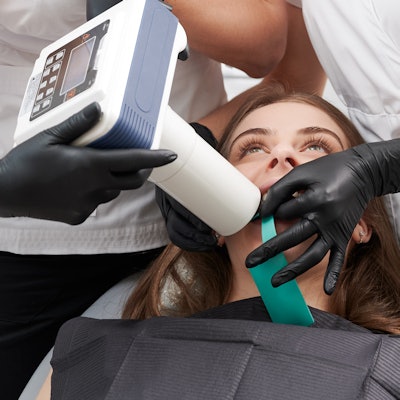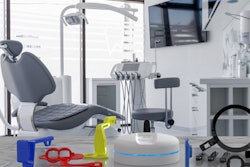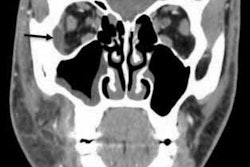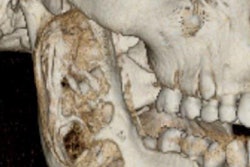
Handheld intraoral x-ray units should not replace conventional fixed dental x-ray machines, according to an editorial published on June 6 in Oral Surgery, Oral Medicine, Oral Pathology and Oral Radiology.
Handheld x-ray devices may increase radiation exposure to users and patients and negatively affect image quality, wrote Dr. James Geist from the University of Detroit Mercy School of Dentistry.
"They should not replace conventional fixed x-ray units but should be used to supplement them," he noted.
Portable intraoral x-ray machines came on the market in the 1990s and have been growing in popularity. They are cost-effective and can benefit apprehensive patients because the systems allow patients not to be left alone during imaging. However, the use of handheld x-ray does come with some safety and efficacy concerns.
Dentists who are considering adding portable handheld x-ray to their practice should be aware of the potential problems, as well as the regulations involved, Geist wrote.
In 2015, the European Academy of DentoMaxilloFacial Radiology recommended that the use of handheld x-ray units be limited to settings such as operating rooms, emergency clinics, and surgical areas where patients may be under general anesthesia. However, the National Council on Radiation Protection and Measurements (NCRP) called the academy's limits too restrictive and announced that portable units were safe for intraoperative endodontic procedures or to take x-rays of children. Meanwhile, the ADA placed no limits on the use of portable x-ray machines as long as clinicians follow certain precautions when using and storing them.
Nevertheless, the following concerns have been noted about the use of handheld devices for radiographs, according to Geist.
1. Possible increase in radiation exposure to operators
Operators of handheld units touch the x-ray generator during procedures, unlike with conventional wall-mounted machines. However, the user does receive protection from the unit's radiation backscatter shield; the U.S. Food and Drug Administration requires portable devices to have such shields. Although evidence has shown that portable devices may increase radiation exposure to users, the radiation levels imparted are typically within permissible levels for occupational exposure, Geist noted.
2. Potential rise in radiation exposure to patients
To minimize radiation dose to dental patients, the NCRP requires that tube potential be lower than 60 kVp and the position-indicating device be open-ended and lined with high-atomic-number materials that absorb scattered photons from the filter at the base of the tube head. Currently, commercially available portable devices only meet the council's minimum standards for tube potential and source-to-skin distance. Additionally, a patient's exposure may increase if an exposure area is enlarged, such as when a clinician moves an x-ray unit farther from the person's head. Prolonged use of a handheld device may lead to operator fatigue, which could lead a user to move the unit closer to the body and farther from the patient.
3. Unacceptable images
Though research suggests x-rays acquired with handheld units are comparable technically to those produced via conventional systems, some aspects of portable units affect image quality. For instance, holding the device, which weighs about 5 lb, for more than a limited number of exposures could lead to operator fatigue. This could lead to errors that may compromise image quality. Fatigue may also lead the operator to inconsistently align the handheld unit and the sensor with the proper orientation. This could lead to poor images, requiring more images to be taken and opening everyone up to additional radiation exposure.
Though portable x-ray devices can offer some benefits, dentists should not rely solely on handheld units, he concluded.
"The overall safety of these systems warrants more widespread approval of their use," Geist wrote.




















